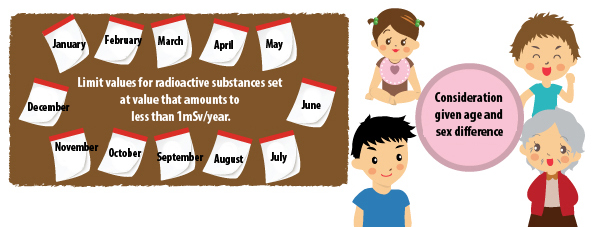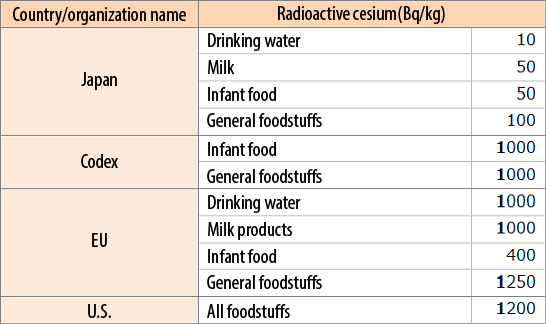Tokyo Food Safety Information Center » Tokyo Metropolitan Government food safety FAQ »What kind of limit values have been established for radioactive substances contained in food?
What kind of limit values have been established for radioactive substances contained in food?

What kind of limit values have been established for radioactive substances contained in food?
- Is cesium the only radioactive substance subject to target values?
- What measures are taken when radioactive substances that exceed the target values are detected?
- Some countries have imposed import restrictions on Japanese food. Is there no danger on Japanese limit values?

The limit value is determined taking into account all generations, including infants, considering differences in food intake and metabolism according age and sex to ensure that the annual radiation dose does not exceed 1mSv.


Limit values are as in the table below.
Table: Limit values for Radioactive Cesium in Food (Unit: Becquerel/kg)

*Scope of “Infant food”: includes milk powder, snacks, and drinks for infants
*Scope of “Milk”: includes low-fat milk, processed milk and milk beverages in addition to milk
The limit values are set to ensure that the annual radiation dose does not exceed 1mSv, and they assume that the radiation dose is 0.1mSv from drinking water and the 0.9mSv is from other than drinking water.
The limit value for drinking water is set lower than for other foods because it is something that everyone, including infants, consumes, intakes are high, and there is no substitute.
The limit value for general foodstuffs is determined taking into consideration differences in food intake, physiques, metabolism, and the effect of radioactivity depending on age and sex.
A special category which is half the value of general foodstuffs has been set for infant food and milk, which children consume more, taking account of the fact that children are considered highly susceptible to radiation.
In addition, the limit values have been set by calculating the ratio of the other radioactive substances released in the accident with a half life of at least one year (strontium 90, plutonium, and ruthenium 106) to radioactive cesium to ensure that the annual radiation dose does not exceed 1mSv even if all those substances are included.
When many agricultural, livestock and marine products in a specific area are found to exceed the limit values as a result of testing, shipment restrictions are implement for the area or individual products. When limit values are exceeded in processed foods, the production site and the origin of the raw materials are investigated to identify the source, and measures that include shipment restrictions for raw materials are taken depending on the case.
At present, some countries are regulating imports of Japanese food, but Japan’s limit values meet the standards set by the Codex Committee that defines international food standards. The limit values set by other countries are as below.
Table: Overseas Indicators for Radioactive Substances in Food (as of March 2016)

Table: Limit values for Radioactive Cesium in Food (Unit: Becquerel/kg)

*Scope of “Infant food”: includes milk powder, snacks, and drinks for infants
*Scope of “Milk”: includes low-fat milk, processed milk and milk beverages in addition to milk
The limit values are set to ensure that the annual radiation dose does not exceed 1mSv, and they assume that the radiation dose is 0.1mSv from drinking water and the 0.9mSv is from other than drinking water.
The limit value for drinking water is set lower than for other foods because it is something that everyone, including infants, consumes, intakes are high, and there is no substitute.
The limit value for general foodstuffs is determined taking into consideration differences in food intake, physiques, metabolism, and the effect of radioactivity depending on age and sex.
A special category which is half the value of general foodstuffs has been set for infant food and milk, which children consume more, taking account of the fact that children are considered highly susceptible to radiation.
In addition, the limit values have been set by calculating the ratio of the other radioactive substances released in the accident with a half life of at least one year (strontium 90, plutonium, and ruthenium 106) to radioactive cesium to ensure that the annual radiation dose does not exceed 1mSv even if all those substances are included.
When many agricultural, livestock and marine products in a specific area are found to exceed the limit values as a result of testing, shipment restrictions are implement for the area or individual products. When limit values are exceeded in processed foods, the production site and the origin of the raw materials are investigated to identify the source, and measures that include shipment restrictions for raw materials are taken depending on the case.
At present, some countries are regulating imports of Japanese food, but Japan’s limit values meet the standards set by the Codex Committee that defines international food standards. The limit values set by other countries are as below.
Table: Overseas Indicators for Radioactive Substances in Food (as of March 2016)
